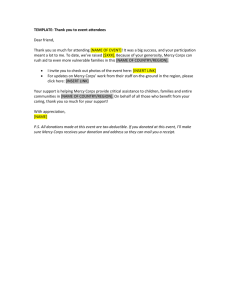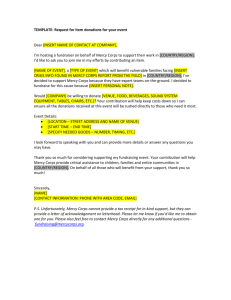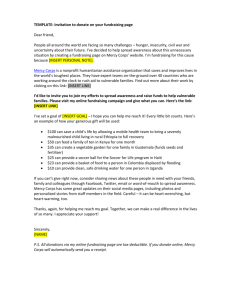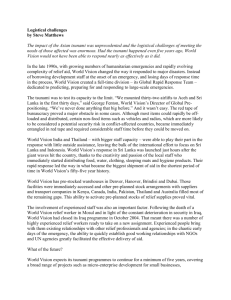Statement of Nancy Lindborg
advertisement
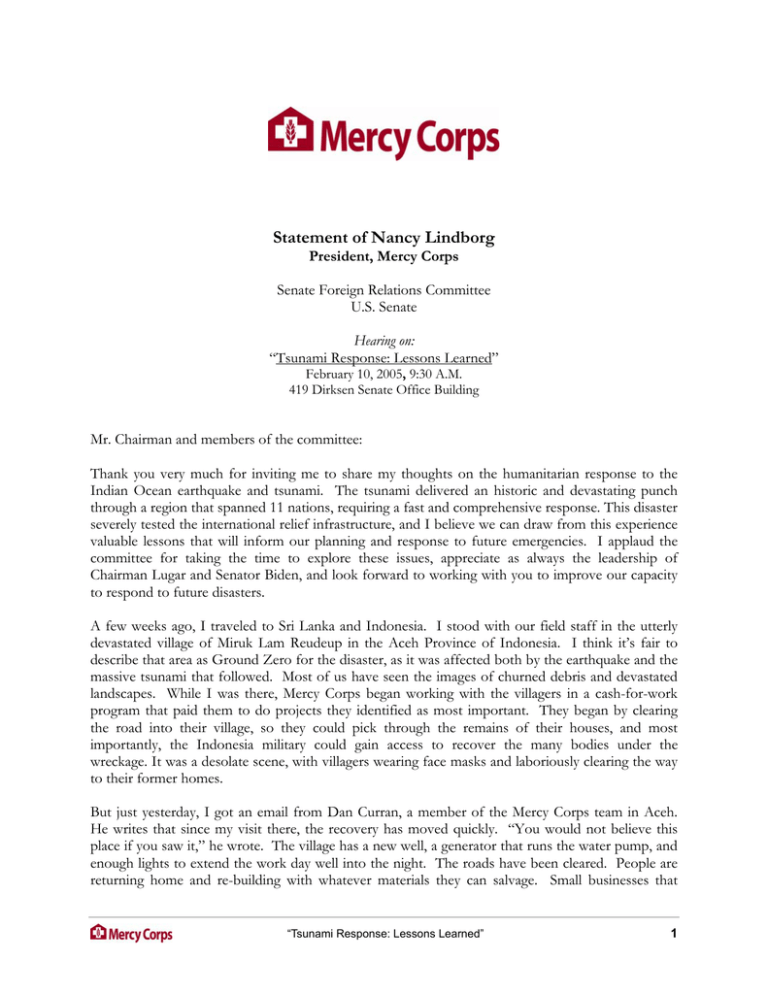
Statement of Nancy Lindborg President, Mercy Corps Senate Foreign Relations Committee U.S. Senate Hearing on: “Tsunami Response: Lessons Learned” February 10, 2005, 9:30 A.M. 419 Dirksen Senate Office Building Mr. Chairman and members of the committee: Thank you very much for inviting me to share my thoughts on the humanitarian response to the Indian Ocean earthquake and tsunami. The tsunami delivered an historic and devastating punch through a region that spanned 11 nations, requiring a fast and comprehensive response. This disaster severely tested the international relief infrastructure, and I believe we can draw from this experience valuable lessons that will inform our planning and response to future emergencies. I applaud the committee for taking the time to explore these issues, appreciate as always the leadership of Chairman Lugar and Senator Biden, and look forward to working with you to improve our capacity to respond to future disasters. A few weeks ago, I traveled to Sri Lanka and Indonesia. I stood with our field staff in the utterly devastated village of Miruk Lam Reudeup in the Aceh Province of Indonesia. I think it’s fair to describe that area as Ground Zero for the disaster, as it was affected both by the earthquake and the massive tsunami that followed. Most of us have seen the images of churned debris and devastated landscapes. While I was there, Mercy Corps began working with the villagers in a cash-for-work program that paid them to do projects they identified as most important. They began by clearing the road into their village, so they could pick through the remains of their houses, and most importantly, the Indonesia military could gain access to recover the many bodies under the wreckage. It was a desolate scene, with villagers wearing face masks and laboriously clearing the way to their former homes. But just yesterday, I got an email from Dan Curran, a member of the Mercy Corps team in Aceh. He writes that since my visit there, the recovery has moved quickly. “You would not believe this place if you saw it,” he wrote. The village has a new well, a generator that runs the water pump, and enough lights to extend the work day well into the night. The roads have been cleared. People are returning home and re-building with whatever materials they can salvage. Small businesses that “Tsunami Response: Lessons Learned” 1 service the reconstruction effort are popping up around town, providing much needed jobs and building supplies. “The people in this village,” Dan wrote, “are several steps ahead of the government and the international NGOs.” Dan’s observation captures well one of my key points today: relief and recovery works best when planned and executed in close partnership with the communities affected by a disaster, whether natural or man-made. Many of these communities have the will and the know-how to shape the best response to the situation—the international community needs to fully use and support these local assets. In responding to the Indian Ocean tsunami, the international NGO community was most effective when it leveraged the energy and ingenuity of the affected communities, when we have made longterm investments in building local capabilities, and when we have the resources and flexibility to support local initiatives. We have passed the critical first month of response. As we reflect on the response to-date, there is much to commend. The world has responded with incredible generosity. Many nations were able to work together to access difficult areas and provide essential services. Schools have reopened in Aceh. Conflicts have abated. Major disease outbreaks have been averted. I think we can be proud of the response. And now the really hard work begins. I would like to offer a few comments from the perspective of an NGO, about the NGO response to this tragedy: 1. ONGOING INVESTMENTS IN LONGER TERM DEVELOPMENT ENABLED A FAST, EFFECTIVE RESPONSE First, many of us had a fast and substantial immediate response to the emergency. Because many of us have been working on the ground in India, Sri Lanka, Sumatra and elsewhere, we were in a position to deploy the right people and resources on very short notice. We were able to do so because we have existing networks of local teams, local partners and suppliers. In those critical first hours after the emergency, it is the people on the ground who are able to reach those affected most quickly. For example, Mercy Corps teams were waiting at the Aceh border as government officials opened that border for the first time in a year and able to cross into Aceh with a seasoned team, an office set-up and supplies. We are able to do so thanks largely to the fact we have several ongoing development focused USDA programs in Sumatra. Through these programs, Mercy Corps distributes soy milk to more than 100,000 schoolchildren and supports local NGOs in microfinance, water and sanitation, capacity building and relief activities. Due to these USDA programs, Mercy Corps was able to quickly redeploy staff, equipment, and resources to Aceh and provide immediate food, temporary shelter, and water to thousands of survivors. Our familiarity with Sumatra and working with the local NGO sector have also proved helpful in our effort to move quickly into community recovery activities, a process that will continue to rely on partnerships with local NGOs and community groups. Within the week, we were distributing food to more than 60,000 individuals using World Food Programme resources. “Tsunami Response: Lessons Learned” 2 2. EARLY DEVELOPMENTAL RELIEF FOCUS SUPPORTED LOCAL CAPACITY Second, Mercy Corps, like some other NGOs, sought and implemented innovations that moved the response quickly into recovery programs. As always, Mercy Corps made an effort to be flexible and entrepreneurial. We looked for gaps in the response and moved immediately to fill them. Mercy Corps participated fully in the effort to meet urgent needs—distribution of food, health and hygiene supplies, household kits and other essentials—but we also immediately started working with local communities to determine the necessary next steps for recovery. The clean-up and income needs in affected areas were tremendous, but so were the supply of labor and enthusiasm among local workers. As I noted earlier, Mercy Corps started a cash-for-work program that paid locals to clear roads, rebuild schools, and maintain IDP camps. We employed more than 1600 people in Banda Aceh alone, giving families the income to buy much-needed staples and making communities livable again. The NGO community was able to work with communities, to assist kids to return to school, help fisherman repair their boats and support a return to their homes. 3. ABILITY TO MOBILIZE PRIVATE RESOURCES ENABLED A FAST AND INNOVATIVE RESPONSE Third, we benefited from an unprecedented amount of private resources. If we ever had any doubt, this crisis proved the enduring value of fast, flexible resource pipelines. Without having to wait for institutional donors, many NGOs were able to move quickly into the affected areas and begin delivering vital assistance. We are essentially the arms and legs of the international response, and this time around, we were resourced so we could mobilize fully and quickly. All too often, we are scraping for funding early on in a crisis while institutional funding sources get underway. As importantly, as the situation changed, we were able to identify innovative solutions and work with communities to devise assistance options that most met their needs. For example, Mercy Corps was able to begin cash-for-work programs as soon as community members identified their desire to get back to work. We were then able to begin investing in small entrepreneurial efforts designed to jumpstart the local economies, providing income and jobs. Once these efforts demonstrated an effective approach, we could scale them up. A cash-for-work program that began with 100 villagers in Miruk Lam Reudeup is now employing more than 2000 workers throughout Aceh, with support from OFDA, OTI and UNDP. Unfortunately, we can’t count on this level of public support, especially for the more complicated and hidden emergencies we typically address. 4. CHALLENGES OF MATERIAL AID REMAIN One of the chronic problems we face in highly publicized humanitarian efforts is too much material aid. Generous and well-meaning people—though schools, workplaces, places of worship—want to contribute to the relief effort and send clothes, food, and other supplies. Unfortunately, those donated items tend to clog up our finite transportation and logistics systems with goods that may not always be a top priority. While in Sri Lanka, I spoke with one village leader who noted a supply “Tsunami Response: Lessons Learned” 3 of neckties and miniskirts he recently received. Although much can be done responsibly with material aid, it must be demand-driven, well-targeted, appropriate and prioritized. The good news is that we’ve made significant progress on this issue. Our collective public reminders that cash donations are most effective in such emergencies seem to be getting through. Mainstream publications carried this message as did Presidents Bush and Clinton. But we need to continue driving home that message because the wrong donated goods continue to gum up the works. 5. COORDINATION SYSTEMS WORKED Despite the appearance of chaos, there is an effective international infrastructure for coordinating these responses. It occurs at many levels: internationally between donors, at a country level, and in each region. Experienced responders know how to constitute this system in each new emergency. In India and Sri Lanka, the governments managed the coordination, while NGOs worked in sector and regional working groups to share information and resources. In Indonesia, the government designated its military leadership to coordinate with the many international militaries that responded, while asking the UN to coordinate the international NGOs and other international organizations. So what does this look like on the ground? In Indonesia for example, there are regular – at first daily – morning meetings with the key UN agencies and NGO representatives to identify top issues of the day. There are then a series of sector specific and regional meetings that appropriate UN, NGO and government representatives attend. The UN Office for the Coordination of Humanitarian Affairs has set up a Humanitarian Information Center to facilitate information exchange. Finally, there is a group of NGOs that meets each week to identify critical issues as well. In practice this means that in Meulaboh, for example, Mercy Corps was able to procure several shipments of dried fish. Catholic Relief Services was distributing a food basket from the World Food Programme, and although they had established the distribution network, they lacked any protein component. Aware of this gap, we gave them the fish for their teams to distribute so villagers would receive a complete food basket. It also means that as difficult and complex issues such as shelter are addressed, there are mechanisms for working together. With nearly 450,000 displaced people in Aceh, the question of shelter is enormous. The majority of those people are living with host families, in a remarkable tribute to the Indonesian concept of “Pella Gandong” or taking care of each other. But even so, there is a need to identify temporary options for nearly 150,000 of the homeless. The Indonesia government, UN and NGO community have set up a joint process for an integrated planning approach with the intention to ensure the best site selection, design and operation of the barracks now proposed in 24 sites. “Tsunami Response: Lessons Learned” 4 6. COLLECTIVE COMMITMENT TO ACCOUNTABILITY AND STANDARDS IN PLACE NGOs have collaborated extensively with one another and with the UN community over the past eight years to develop increased levels of accountability and effectiveness in our relief operations. The results are evident in the standards agreed by InterAction, an association of 160 US-based relief and development organizations, and in the Sphere Humanitarian Charter and Minimum Standards in Disaster Response. Mercy Corps field staff in Aceh report that the level of understanding and adherence to the Sphere standards among the established NGOs has been unprecedented, which has brought a greater degree of accountability and uniformity to the effort. Two critical challenges stem from the inevitable ranks of highly motivated often brand-new organizations and individuals that are compelled to respond. As is often the case, they flocked to the tsunami-affected areas, swelled the ranks and made coordination more difficult. This is not a new phenomenon and usually quiets down after the first few weeks, but it does increase an impression of chaos that can be misleading. In addition, many new or less experienced organizations that don’t meet key standards undermine the effectiveness of our collective response and divert valuable resources from the collective effort. To conclude, I would offer the following recommendations as we assess our performance in the Indian Ocean region and explore ways to plan and execute better humanitarian responses in the future: 1. Establish a mechanism for rapid disbursement of U.S. government relief funds. As I mentioned above, this extraordinary tragedy brought about extraordinary generosity from individual donors; as a result, private funds financed our initial response and allowed us to be unusually nimble in our programming. In many of the most severe crises though, governments provide the vast majority of the funds. We need to streamline the mechanism for distributing fast, long-term and flexible response funds from the government. 2. Make solid investments in developing countries. Local communities and governments were key to the sound responses in Indonesia, Sri Lanka and India. When we invest in longterm development—building stronger governance structures, expanding educational opportunities, enhancing the health infrastructure—we improve livelihoods and better equip beneficiary communities to deal with disasters. Furthermore, these investments allow NGOs like Mercy Corps to establish the kind of presence—a forward position, if you will—that enables us to quickly deploy knowledgeable local and international staff to the crisis area. Country experience among NGO staff was especially important in this crisis, since both Sri Lanka and the Aceh Province of Indonesia have longstanding internal conflict dynamics that affect response strategies and implementation. For these reasons, development assistance needs to be a top priority for the U.S. government. As the discussion gets underway on the President’s FY2006 budget request, “Tsunami Response: Lessons Learned” 5 please consider the need to ensure that core development accounts are maintained or improved. 3. Focus immediately on development relief and restoring livelihoods. Delivering food aid and non-food emergency supplies will remain the immediate priority in humanitarian crises. But as Mercy Corps learned on the ground in Indonesia and Sri Lanka, we must simultaneously work to get people back on the job: farmers to their fields, fishermen to their boats, merchants to their shops, teachers and students to their classrooms. Instead of focusing on a false distinction between “relief” and “recovery” phases, we need to manage the two in parallel. 4. Prioritize local resources and community partnerships. In procuring relief supplies and staffing our missions, we should use local suppliers and talent whenever possible. That ensures the most locally appropriate goods and services and pumps much-needed money into the local economies. Most NGOs do their very best to develop local talent, which is especially important in the two hardest-hit areas in the tsunami-affected regions: because of the dynamics of local conflicts, governments are unlikely to permit international staff to stay indefinitely and we will need to rely heavily on local staff to accomplish recovery goals over the longer term. Partnerships with local groups and leaders help guarantee that our efforts are meeting the greatest community needs. Mercy Corps worked closely with survivors in the devastated Indonesian town of Meulaboh to determine how we could contribute. The town’s profitable fishing fleet was all but demolished by the tsunami, so we worked with leaders to organize the fisherman and pay them to move and repair boats that could be salvaged. Within weeks, fishermen were back on the water generating income for their families. Challenges Ahead: As I noted earlier, the serious, complex and long-term effort of rebuilding these communities lies ahead. In Sri Lanka and Indonesia, there are tangled conflicts that remain just barely below the surface. These countries will have to grapple with the many complicated issues related to rebuilding an entire human and physical infrastructure. They will have to painstakingly restore whole cadres of government workers killed or wounded by the tsunami. The role that we as international NGOs can continue to play is a supportive one. We take our cue from the many people who have survived and now lead the way with their determination to rebuild their lives. We can and will continue to help people plug as quickly as possible back into a life in which they can begin the long process of healing, make a living and rebuild both their houses and their community. “Tsunami Response: Lessons Learned” 6 Attachment: Summary of Mercy Corps Tsunami Response Operations Mercy Corps is concentrating its relief and recovery efforts in three nations: Indonesia, Sri Lanka, and India. At present, our tsunami response operations are assisting more than 250,000 people throughout the region, including over 130,000 in Sri Lanka, over 75,000 in Indonesia, and over 50,000 in India. More than 150 Mercy Corps staff members are engaged in these activities, which focus primarily on economic and livelihood recovery and, where necessary, ongoing emergency relief assistance. Mercy Corps is also exploring recovery needs in northern Somalia with an eye towards providing assistance to tsunami affected communities in that country. The emphasis during the initial phase of our response has been to meet the most urgent emergency needs through the provision of clean water and repair of sanitation facilities, as well as the provision of sanitation supplies, food, blankets, and other non-food items, shelter materials, tools, and medicines. In addition, we are assisting with psychosocial services, clean-up, and access to other basic services. From the start, we have worked to tie emergency relief with longer-term development activities. Cash for work programs are repairing damaged infrastructure, while providing participants with an opportunity to earn income and regain a sense of normalcy. As always, we are working in coordination with other aid agencies, supporting local non-governmental organizations (NGOs) responding to the disaster, and moving as quickly as possible to address the significant economic and livelihood challenges faced by these coastal communities. Following is a brief summary of Mercy Corps operations in the region: Indonesia A Mercy Corps team was among the first humanitarian workers to gain entry into Banda Aceh, an area of Indonesia that's been closed off to the world for years due to civil war. In addition to helping meet immediate food, water, and shelter needs, Mercy Corps has been making special efforts to address the long-term needs of children, the most vulnerable of those affected by the tsunami. On January 26 - one month after the tsunami - Mercy Corps helped students in Banda Aceh return to 15 local schools. This "back to school" success was made possible by community mobilization and the hard work of local citizens employed in cash for work programs. Mercy Corps' cash for work programs pay local workers a fair daily wage to help clean up debris and repair critical infrastructure. This approach is helping accelerate economic recovery among Indonesian families, as well as providing a valuable service in rebuilding tsunami-damaged areas. Within three months, Mercy Corps plans to employ 6,000 people in cash-for-work programs that will continue to clean up and restore communities. We are also working to facilitate the stable return of at least 1,000 displaced families to several villages by providing shelter materials and ensuring a clean water supply. In the coming months, Mercy Corps will increasingly focus its efforts on programs that stimulate local business and help communities rebuild. Programs already underway included business activities, such as pallet building and loans for brick enterprises, as well as the recapitalization of local businesses to expand employment. Along these lines, Mercy Corps aims to support at least 100 enterprises in twenty villages in the coming months. Finally, we are supporting the return of at least 1,000 families in several villages, facilitating “go-and-see” visits, distributing family kits for communities in their area of return, providing basic shelter materials, and conducting basic well water chlorination. “Tsunami Response: Lessons Learned” 7 Sri Lanka Mercy Corps staff members are partnering with local organizations to ensure a rapid, efficient response in the areas where assistance is most needed, especially the hard hit Ampara District on the eastern coast of Sri Lanka. Currently, Mercy Corps has eight international aid workers in the country and offices in Colombo, Pottuvil and Trincomalee. Senior Mercy Corps staff members have years of experience in Sri Lanka, and Mercy Corps completed an assessment visit to Sri Lanka in mid-December, less than two weeks before the disaster. This presence and expertise allows us to build on a broad and deep foundation of local contacts. Mercy Corps has provided school materials to children, and supported children’s recreation programs in the camps that many on Sri Lanka’s eastern coast temporarily inhabit. Mercy Corps is also helping to rehabilitate the severely damaged local maritime economy, by supporting the repair of fishing boats. Mercy Corps has provided materials for clean up, distributed shelter supplies, initiated a public health information campaign and is implementing cash for work programs in a number of communities throughout the country. Much of Mercy Corps’ emergency relief support has been provided in partnership with local non-governmental organizations responding to the disaster. India Working with local Indian organizations, Mercy Corps is assisting tens of thousands of people in Tamil Nadu, India. Mercy Corps has partnered with the DHAN Foundation to launch relief and recovery efforts in 20 of 73 villages in Tamil Nadu’s Nagappattinam district (population 196,000). Efforts include distribution of temporary shelter and relief supplies, construction of community activity centers, and cash for work programs to help improve and reclaim agricultural land and livelihoods and improve local water sources. Working with the national humanitarian organization DMI (Disaster Mitigation Institute), Mercy Corps has completed construction of roughly 350 temporary shelters, with construction of a further 100 now underway. Mercy Corps has also distributed household kits and food to almost 800 tsunami-affected families. FOR MORE INFORMATION AND LATEST NEWS PLEASE VISIT: www.MercyCorps.org “Tsunami Response: Lessons Learned” 8

